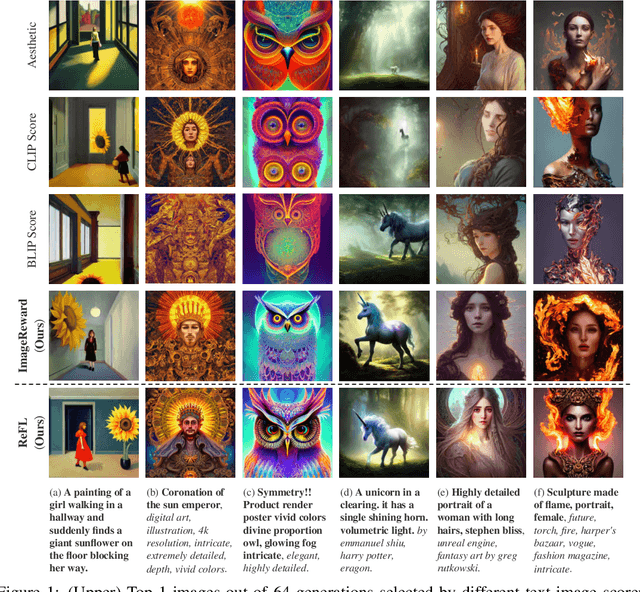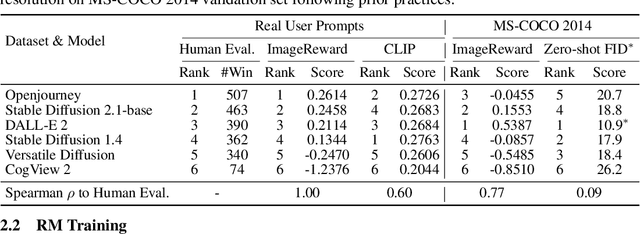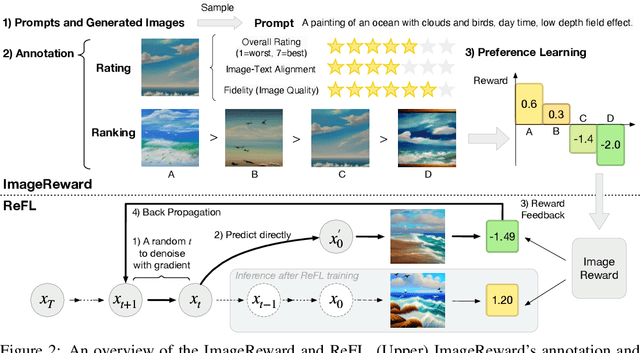Jiazheng Xu
VPO: Aligning Text-to-Video Generation Models with Prompt Optimization
Mar 26, 2025Abstract:Video generation models have achieved remarkable progress in text-to-video tasks. These models are typically trained on text-video pairs with highly detailed and carefully crafted descriptions, while real-world user inputs during inference are often concise, vague, or poorly structured. This gap makes prompt optimization crucial for generating high-quality videos. Current methods often rely on large language models (LLMs) to refine prompts through in-context learning, but suffer from several limitations: they may distort user intent, omit critical details, or introduce safety risks. Moreover, they optimize prompts without considering the impact on the final video quality, which can lead to suboptimal results. To address these issues, we introduce VPO, a principled framework that optimizes prompts based on three core principles: harmlessness, accuracy, and helpfulness. The generated prompts faithfully preserve user intents and, more importantly, enhance the safety and quality of generated videos. To achieve this, VPO employs a two-stage optimization approach. First, we construct and refine a supervised fine-tuning (SFT) dataset based on principles of safety and alignment. Second, we introduce both text-level and video-level feedback to further optimize the SFT model with preference learning. Our extensive experiments demonstrate that VPO significantly improves safety, alignment, and video quality compared to baseline methods. Moreover, VPO shows strong generalization across video generation models. Furthermore, we demonstrate that VPO could outperform and be combined with RLHF methods on video generation models, underscoring the effectiveness of VPO in aligning video generation models. Our code and data are publicly available at https://github.com/thu-coai/VPO.
VisionReward: Fine-Grained Multi-Dimensional Human Preference Learning for Image and Video Generation
Dec 30, 2024Abstract:We present a general strategy to aligning visual generation models -- both image and video generation -- with human preference. To start with, we build VisionReward -- a fine-grained and multi-dimensional reward model. We decompose human preferences in images and videos into multiple dimensions, each represented by a series of judgment questions, linearly weighted and summed to an interpretable and accurate score. To address the challenges of video quality assessment, we systematically analyze various dynamic features of videos, which helps VisionReward surpass VideoScore by 17.2% and achieve top performance for video preference prediction. Based on VisionReward, we develop a multi-objective preference learning algorithm that effectively addresses the issue of confounding factors within preference data. Our approach significantly outperforms existing image and video scoring methods on both machine metrics and human evaluation. All code and datasets are provided at https://github.com/THUDM/VisionReward.
LongBench v2: Towards Deeper Understanding and Reasoning on Realistic Long-context Multitasks
Dec 19, 2024



Abstract:This paper introduces LongBench v2, a benchmark designed to assess the ability of LLMs to handle long-context problems requiring deep understanding and reasoning across real-world multitasks. LongBench v2 consists of 503 challenging multiple-choice questions, with contexts ranging from 8k to 2M words, across six major task categories: single-document QA, multi-document QA, long in-context learning, long-dialogue history understanding, code repository understanding, and long structured data understanding. To ensure the breadth and the practicality, we collect data from nearly 100 highly educated individuals with diverse professional backgrounds. We employ both automated and manual review processes to maintain high quality and difficulty, resulting in human experts achieving only 53.7% accuracy under a 15-minute time constraint. Our evaluation reveals that the best-performing model, when directly answers the questions, achieves only 50.1% accuracy. In contrast, the o1-preview model, which includes longer reasoning, achieves 57.7%, surpassing the human baseline by 4%. These results highlight the importance of enhanced reasoning ability and scaling inference-time compute to tackle the long-context challenges in LongBench v2. The project is available at https://longbench2.github.io.
CogVideoX: Text-to-Video Diffusion Models with An Expert Transformer
Aug 12, 2024Abstract:We introduce CogVideoX, a large-scale diffusion transformer model designed for generating videos based on text prompts. To efficently model video data, we propose to levearge a 3D Variational Autoencoder (VAE) to compress videos along both spatial and temporal dimensions. To improve the text-video alignment, we propose an expert transformer with the expert adaptive LayerNorm to facilitate the deep fusion between the two modalities. By employing a progressive training technique, CogVideoX is adept at producing coherent, long-duration videos characterized by significant motions. In addition, we develop an effective text-video data processing pipeline that includes various data preprocessing strategies and a video captioning method. It significantly helps enhance the performance of CogVideoX, improving both generation quality and semantic alignment. Results show that CogVideoX demonstrates state-of-the-art performance across both multiple machine metrics and human evaluations. The model weights of both the 3D Causal VAE and CogVideoX are publicly available at https://github.com/THUDM/CogVideo.
AlignMMBench: Evaluating Chinese Multimodal Alignment in Large Vision-Language Models
Jun 14, 2024Abstract:Evaluating the alignment capabilities of large Vision-Language Models (VLMs) is essential for determining their effectiveness as helpful assistants. However, existing benchmarks primarily focus on basic abilities using nonverbal methods, such as yes-no and multiple-choice questions. In this paper, we address this gap by introducing AlignMMBench, a comprehensive alignment benchmark specifically designed for emerging Chinese VLMs. This benchmark is meticulously curated from real-world scenarios and Chinese Internet sources, encompassing thirteen specific tasks across three categories, and includes both single-turn and multi-turn dialogue scenarios. Incorporating a prompt rewrite strategy, AlignMMBench encompasses 1,054 images and 4,978 question-answer pairs. To facilitate the evaluation pipeline, we propose CritiqueVLM, a rule-calibrated evaluator that exceeds GPT-4's evaluation ability. Finally, we report the performance of representative VLMs on AlignMMBench, offering insights into the capabilities and limitations of different VLM architectures. All evaluation codes and data are available on https://alignmmbench.github.io.
On the Out-Of-Distribution Generalization of Multimodal Large Language Models
Feb 09, 2024Abstract:We investigate the generalization boundaries of current Multimodal Large Language Models (MLLMs) via comprehensive evaluation under out-of-distribution scenarios and domain-specific tasks. We evaluate their zero-shot generalization across synthetic images, real-world distributional shifts, and specialized datasets like medical and molecular imagery. Empirical results indicate that MLLMs struggle with generalization beyond common training domains, limiting their direct application without adaptation. To understand the cause of unreliable performance, we analyze three hypotheses: semantic misinterpretation, visual feature extraction insufficiency, and mapping deficiency. Results identify mapping deficiency as the primary hurdle. To address this problem, we show that in-context learning (ICL) can significantly enhance MLLMs' generalization, opening new avenues for overcoming generalization barriers. We further explore the robustness of ICL under distribution shifts and show its vulnerability to domain shifts, label shifts, and spurious correlation shifts between in-context examples and test data.
CogAgent: A Visual Language Model for GUI Agents
Dec 21, 2023



Abstract:People are spending an enormous amount of time on digital devices through graphical user interfaces (GUIs), e.g., computer or smartphone screens. Large language models (LLMs) such as ChatGPT can assist people in tasks like writing emails, but struggle to understand and interact with GUIs, thus limiting their potential to increase automation levels. In this paper, we introduce CogAgent, an 18-billion-parameter visual language model (VLM) specializing in GUI understanding and navigation. By utilizing both low-resolution and high-resolution image encoders, CogAgent supports input at a resolution of 1120*1120, enabling it to recognize tiny page elements and text. As a generalist visual language model, CogAgent achieves the state of the art on five text-rich and four general VQA benchmarks, including VQAv2, OK-VQA, Text-VQA, ST-VQA, ChartQA, infoVQA, DocVQA, MM-Vet, and POPE. CogAgent, using only screenshots as input, outperforms LLM-based methods that consume extracted HTML text on both PC and Android GUI navigation tasks -- Mind2Web and AITW, advancing the state of the art. The model and codes are available at https://github.com/THUDM/CogVLM .
CogVLM: Visual Expert for Pretrained Language Models
Nov 06, 2023Abstract:We introduce CogVLM, a powerful open-source visual language foundation model. Different from the popular shallow alignment method which maps image features into the input space of language model, CogVLM bridges the gap between the frozen pretrained language model and image encoder by a trainable visual expert module in the attention and FFN layers. As a result, CogVLM enables deep fusion of vision language features without sacrificing any performance on NLP tasks. CogVLM-17B achieves state-of-the-art performance on 10 classic cross-modal benchmarks, including NoCaps, Flicker30k captioning, RefCOCO, RefCOCO+, RefCOCOg, Visual7W, GQA, ScienceQA, VizWiz VQA and TDIUC, and ranks the 2nd on VQAv2, OKVQA, TextVQA, COCO captioning, etc., surpassing or matching PaLI-X 55B. Codes and checkpoints are available at https://github.com/THUDM/CogVLM.
ImageReward: Learning and Evaluating Human Preferences for Text-to-Image Generation
Apr 13, 2023



Abstract:We present ImageReward -- the first general-purpose text-to-image human preference reward model -- to address various prevalent issues in generative models and align them with human values and preferences. Its training is based on our systematic annotation pipeline that covers both the rating and ranking components, collecting a dataset of 137k expert comparisons to date. In human evaluation, ImageReward outperforms existing scoring methods (e.g., CLIP by 38.6\%), making it a promising automatic metric for evaluating and improving text-to-image synthesis. The reward model is publicly available via the \texttt{image-reward} package at \url{https://github.com/THUDM/ImageReward}.
Regulatory Instruments for Fair Personalized Pricing
Feb 09, 2022



Abstract:Personalized pricing is a business strategy to charge different prices to individual consumers based on their characteristics and behaviors. It has become common practice in many industries nowadays due to the availability of a growing amount of high granular consumer data. The discriminatory nature of personalized pricing has triggered heated debates among policymakers and academics on how to design regulation policies to balance market efficiency and equity. In this paper, we propose two sound policy instruments, i.e., capping the range of the personalized prices or their ratios. We investigate the optimal pricing strategy of a profit-maximizing monopoly under both regulatory constraints and the impact of imposing them on consumer surplus, producer surplus, and social welfare. We theoretically prove that both proposed constraints can help balance consumer surplus and producer surplus at the expense of total surplus for common demand distributions, such as uniform, logistic, and exponential distributions. Experiments on both simulation and real-world datasets demonstrate the correctness of these theoretical results. Our findings and insights shed light on regulatory policy design for the increasingly monopolized business in the digital era.
 Add to Chrome
Add to Chrome Add to Firefox
Add to Firefox Add to Edge
Add to Edge